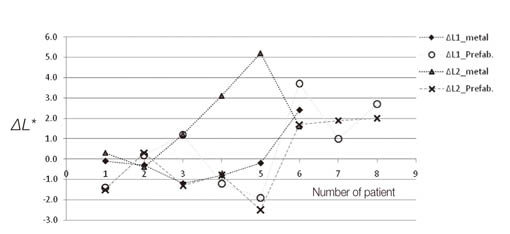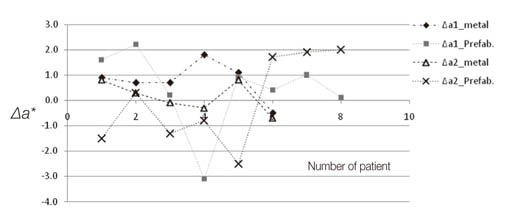J Adv Prosthodont.
2013 Aug;5(3):319-325. 10.4047/jap.2013.5.3.319.
Effect of the shades of background substructures on the overall color of zirconia-based all-ceramic crowns
- Affiliations
-
- 1Prosthodontics Department, Faculty of Dentistry Mahidol University, Bangkok, Thailand. kallaya.sup@mahidol.ac.th
- KMID: 2118172
- DOI: http://doi.org/10.4047/jap.2013.5.3.319
Abstract
- PURPOSE
The objective of this study was to determine the effect of the color of a background substructure on the overall color of a zirconia-based all-ceramic crown.
MATERIALS AND METHODS
Twenty one posterior zirconia crowns were made for twenty subjects. Seven premolar crowns and six molar crowns were cemented onto abutments with metal post and core in the first and second group. In the third group, eight molar crowns were cemented onto abutments with a prefabricated post and composite core build-up. The color measurements of all-ceramic crowns were made before try-in, before and after cementation. A repeated measure ANOVA was used for a statistical analysis of a color change of all-ceramic crowns at alpha=.05. Twenty four zirconia specimens, with different core thicknesses (0.4-1 mm) were also prepared to obtain the contrast ratio of zirconia materials after veneering.
RESULTS
L*, a*, and b* values of all-ceramic crowns cemented either on a metal cast post and core or on a prefabricated post did not show significant changes (P>.05). However, the slight color changes of zirconia crowns were detected and represented by DeltaE*ab values, ranging from 1.2 to 3.1. The contrast ratios of zirconia specimens were 0.92-0.95 after veneering.
CONCLUSION
No significant differences were observed between the L*, a*, and b* values of zirconia crowns cemented either on a metal cast post and core or a prefabricated post and composite core. However, the color of a background substructure could affect the overall color of posterior zirconia restorations with clinically recommended core thickness according to DeltaE*ab values.
Keyword
Figure
Cited by 1 articles
-
Choice of resin cement shades for a high-translucency zirconia product to mask dark, discolored or metal substrates
Shiqi Dai, Chen Chen, Mo Tang, Ying Chen, Lu Yang, Feng He, Bingzhuo Chen, Haifeng Xie
J Adv Prosthodont. 2019;11(5):286-296. doi: 10.4047/jap.2019.11.5.286.
Reference
-
1. Coornaert J, Adriaens P, De Boever J. Long-term clinical study of porcelain-fused-to-gold restorations. J Prosthet Dent. 1984; 51:338–342.2. Walton TR. An up to 15-year longitudinal study of 515 metal-ceramic FPDs: Part 1. Outcome. Int J Prosthodont. 2002; 15:439–445.3. Näpänkangas R, Raustia A. Twenty-year follow-up of metal-ceramic single crowns: a retrospective study. Int J Prosthodont. 2008; 21:307–311.4. Heffernan MJ, Aquilino SA, Diaz-Arnold AM, Haselton DR, Stanford CM, Vargas MA. Relative translucency of six all-ceramic systems. Part I: core materials. J Prosthet Dent. 2002; 88:4–9.5. Heffernan MJ, Aquilino SA, Diaz-Arnold AM, Haselton DR, Stanford CM, Vargas MA. Relative translucency of six all-ceramic systems. Part II: core and veneer materials. J Prosthet Dent. 2002; 88:10–15.6. Chen YM, Smales RJ, Yip KH, Sung WJ. Translucency and biaxial flexural strength of four ceramic core materials. Dent Mater. 2008; 24:1506–1511.7. Kingery WD. Introduction to ceramics. 2nd ed. New York: Wiley Interscience;1975. p. 516–580. p. 6668. Klein GA. Industrial color physics. New York: Springer Science+Business Media, LLC;2010. p. 185–186.9. Antonson SA, Anusavice KJ. Contrast ratio of veneering and core ceramics as a function of thickness. Int J Prosthodont. 2001; 14:316–320.10. Chu FC, Sham AS, Luk HW, Andersson B, Chai J, Chow TW. Threshold contrast ratio and masking ability of porcelain veneers with high-density alumina cores. Int J Prosthodont. 2004; 17:24–28.11. Yu B, Ahn JS, Lee YK. Measurement of translucency of tooth enamel and dentin. Acta Odontol Scand. 2009; 67:57–64.12. Sakaguchi RL, Powers JM. Craig's restorative dental materials. 12th ed. Mosby Elsevier;2006. p. 33.13. Johnston WM, Kao EC. Assessment of appearance match by visual observation and clinical colorimetry. J Dent Res. 1989; 68:819–822.14. Douglas RD, Steinhauer TJ, Wee AG. Intraoral determination of the tolerance of dentists for perceptibility and acceptability of shade mismatch. J Prosthet Dent. 2007; 97:200–208.15. Seghi RR, Hewlett ER, Kim J. Visual and instrumental colorimetric assessments of small color differences on translucent dental porcelain. J Dent Res. 1989; 68:1760–1764.16. Douglas RD, Brewer JD. Acceptability of shade differences in metal ceramic crowns. J Prosthet Dent. 1998; 79:254–260.17. Ishikawa-Nagai S, Yoshida A, Sakai M, Kristiansen J, Da Silva JD. Clinical evaluation of perceptibility of color differences between natural teeth and all-ceramic crowns. J Dent. 2009; 37:e57–e63.18. Guazzato M, Albakry M, Ringer SP, Swain MV. Strength, fracture toughness and microstructure of a selection of all-ceramic materials. Part II. Zirconia-based dental ceramics. Dent Mater. 2004; 20:449–456.19. Carter CB, Norton MG. Ceramic materials: Science and engineering. New York: Springer Science+Business Media, LLC.;2007. p. 583.20. Baldissara P, Llukacej A, Ciocca L, Valandro FL, Scotti R. Translucency of zirconia copings made with different CAD/CAM systems. J Prosthet Dent. 2010; 104:6–12.21. Karaagaclioglu L, Terzioglu H, Yilmaz B, Yurdukoru B. In vivo and in vitro assessment of an intraoral dental colorimeter. J Prosthodont. 2010; 19:279–285.22. Li Q, Wang YN. Comparison of shade matching by visual observation and an intraoral dental colorimeter. J Oral Rehabil. 2007; 34:848–854.23. Denry I, Kelly JR. State of the art of zirconia for dental applications. Dent Mater. 2008; 24:299–307.24. Callister WD. Materials science and engineering. 4th ed. New York: John Wiley & Sons, Inc.;1997. p. 697–703.25. Paul SJ, Pliska P, Pietrobon N, Schärer P. Light transmission of composite luting resins. Int J Periodontics Restorative Dent. 1996; 16:164–173.26. Azer SS, Ayash GM, Johnston WM, Khalil MF, Rosenstiel SF. Effect of esthetic core shades on the final color of IPS Empress all-ceramic crowns. J Prosthet Dent. 2006; 96:397–401.27. Vichi A, Ferrari M, Davidson CL. Influence of ceramic and cement thickness on the masking of various types of opaque posts. J Prosthet Dent. 2000; 83:412–417.28. Li Q, Yu H, Wang YN. Spectrophotometric evaluation of the optical influence of core build-up composites on all-ceramic materials. Dent Mater. 2009; 25:158–165.29. Shimada K, Nakazawa M, Kakehashi Y, Matsumura H. Influence of abutment materials on the resultant color of heat-pressed lithium disilicate ceramics. Dent Mater J. 2006; 25:20–25.30. Nakamura T, Saito O, Fuyikawa J, Ishigaki S. Influence of abutment substrate and ceramic thickness on the colour of heat-pressed ceramic crowns. J Oral Rehabil. 2002; 29:805–809.31. Terzioğlu H, Yilmaz B, Yurdukoru B. The effect of different shades of specific luting agents and IPS empress ceramic thickness on overall color. Int J Periodontics Restorative Dent. 2009; 29:499–505.32. de Azevedo Cubas GB, Camacho GB, Demarco FF, Pereira-Cenci T. The Effect of Luting Agents and Ceramic Thickness on the Color Variation of Different Ceramics against a Chromatic Background. Eur J Dent. 2011; 5:245–252.33. Chang J, Da Silva JD, Sakai M, Kristiansen J, Ishikawa-Nagai S. The optical effect of composite luting cement on all ceramic crowns. J Dent. 2009; 37:937–943.
- Full Text Links
- Actions
-
Cited
- CITED
-
- Close
- Share
- Similar articles
-
- Colorimetric Analysis of Preformed Zirconia Anterior Crowns for Esthetic Restoration
- Marginal fit of the digident CAD/CAM zirconia ceramic crowns
- Fracture strength of zirconia ceramic crowns according to tooth position
- Fracture strength of zirconia monolithic crowns and metal-ceramic crowns after cyclic loading and thermocycling
- Influences of luting cement shade on the color of various translucent monolithic zirconia and lithium disilicate ceramics for veneer restorations




